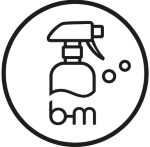
Dog shampoo
What you’ll need
-
Castile Soap
-
Tapwater
Method
- Start by using the shower head to completely soak your dog’s fur.
- Next, work in some Castile Soap, massaging it in until it creates a nice, foamy lather.
- Rinse your dog thoroughly with clean water, making sure all the soap is washed out.
- Repeat a second time if needed!
Use for:
Wash your dog the eco-friendly way.

Waxed floors:
Do not use Castile Soap on waxed or oiled wood floors, because it could break down the wax.

Mixing with acids:
Since Castile Soap is alkaline, you shouldn‘t mix it directly with acidic substances like lemon juice, Citric Acid or vinegar. Acid will react with the soap itself and break apart the soap molecules and neutralize its effects.

Hard Water:
Whilst Castile Soap is a very reliable and mild cleaner, it can leave a residue on shiny or hard surfaces, especially when it‘s used with hard water (the soap reacts with minerals from the water to form a salt). Use Castile Soap with distilled water if you live in a hard water area or cut through the leftover residue by applying an acid rinse afterwards like this Citric Acid solution: 1tsp Citric Acid in 250ml, spray onto surfaces and wipe away any residues.
Store Castile Soap sealed tightly, in a cool, dry place, away from direct sunlight and out of reach of children and pets.
Our fragrance-free Organic Castile Soap is hypoallergenic, pet- and skin-safe, which means it‘s less likely to cause allergic reactions than other types of soap. Needs dilution: If you don‘t dilute Castile Soap with water, it can be very concentrated. This can make it hard on surfaces and the skin.
